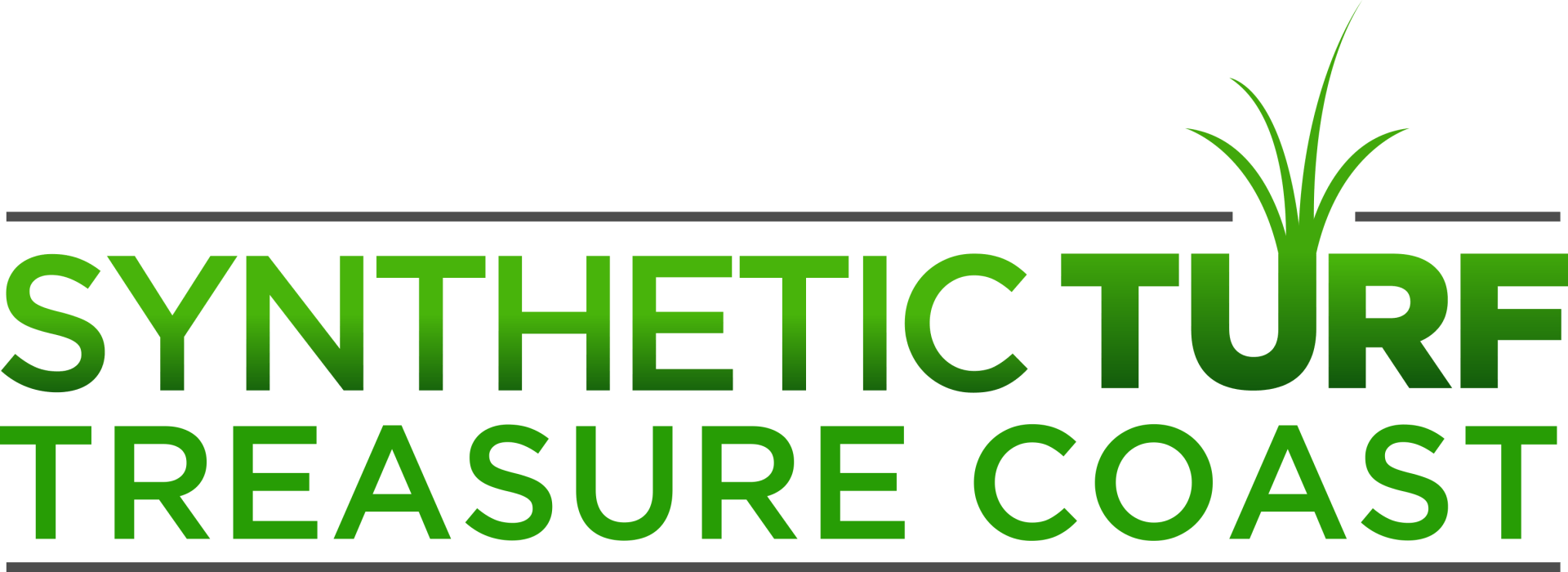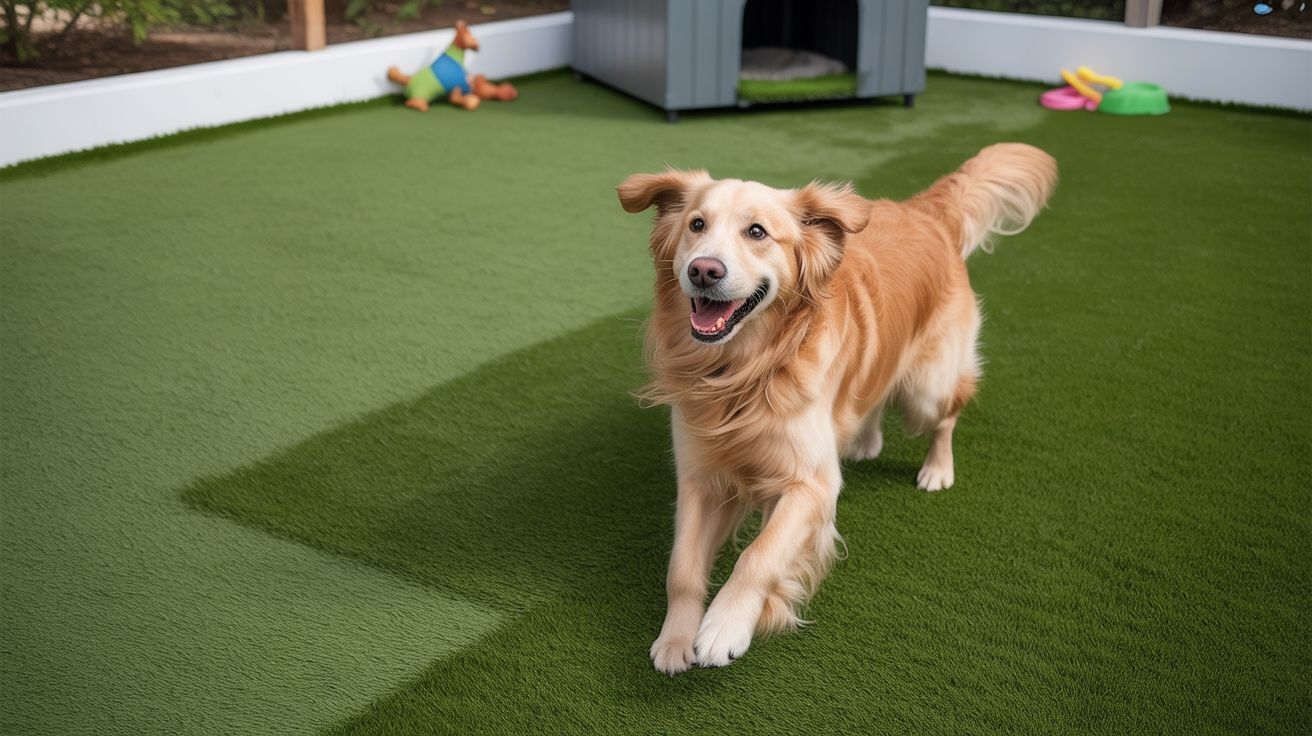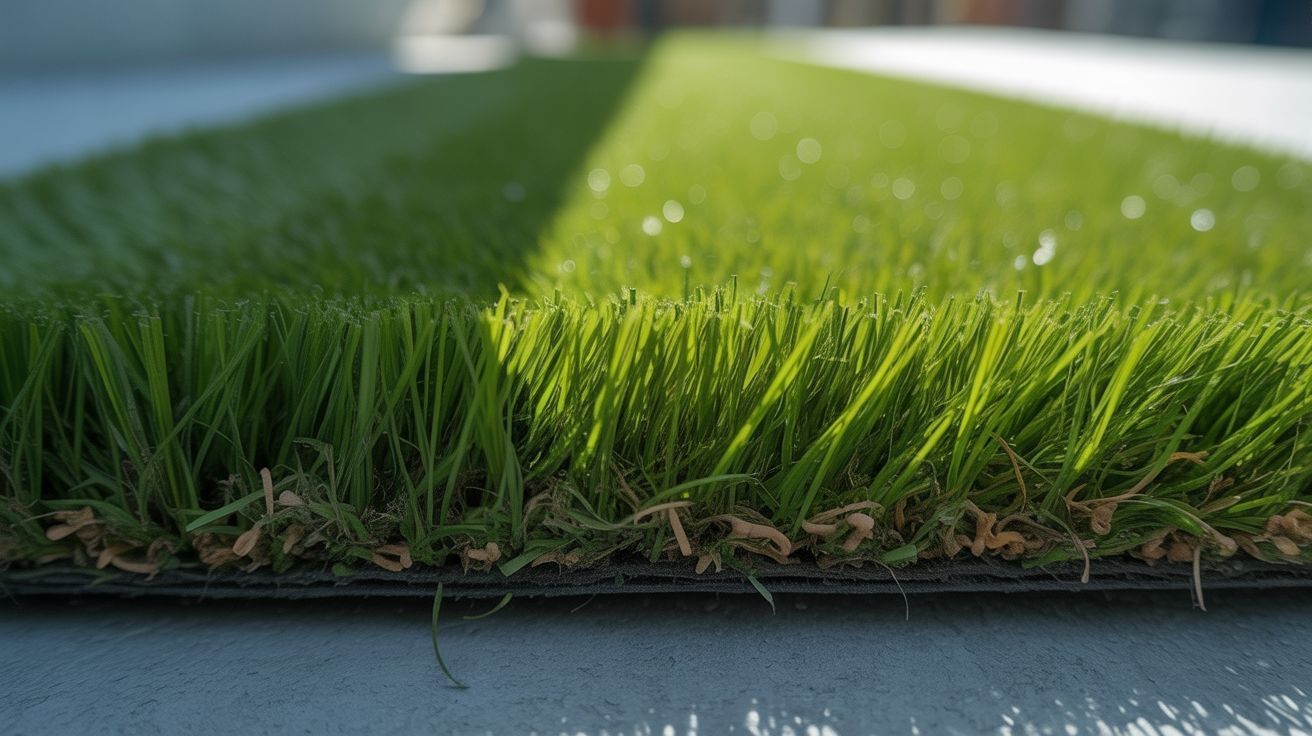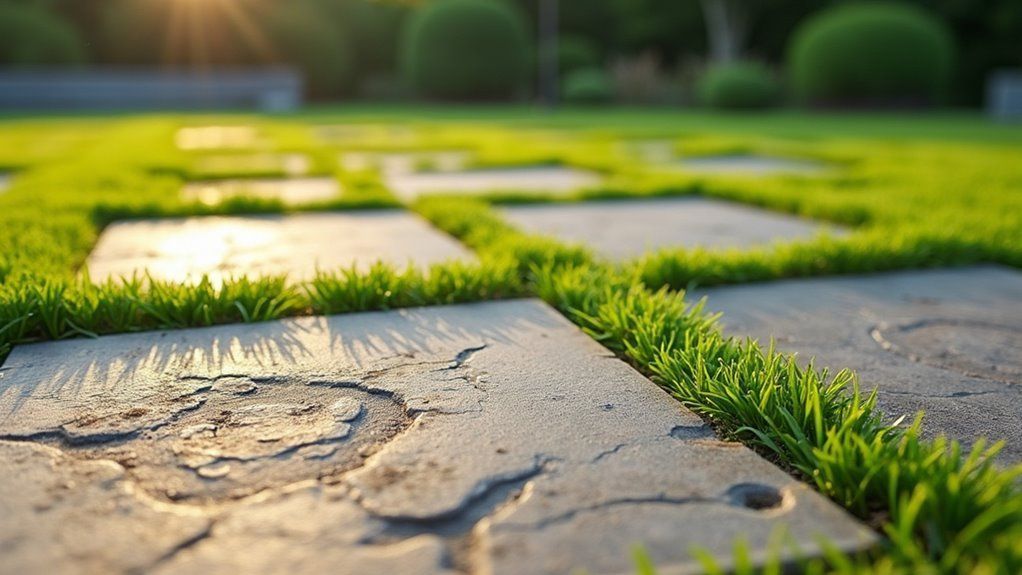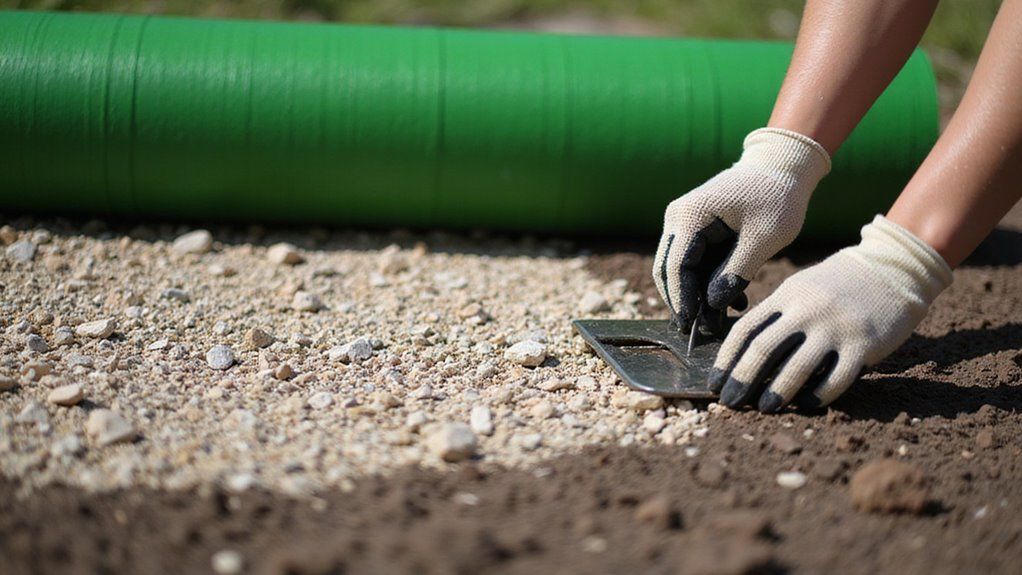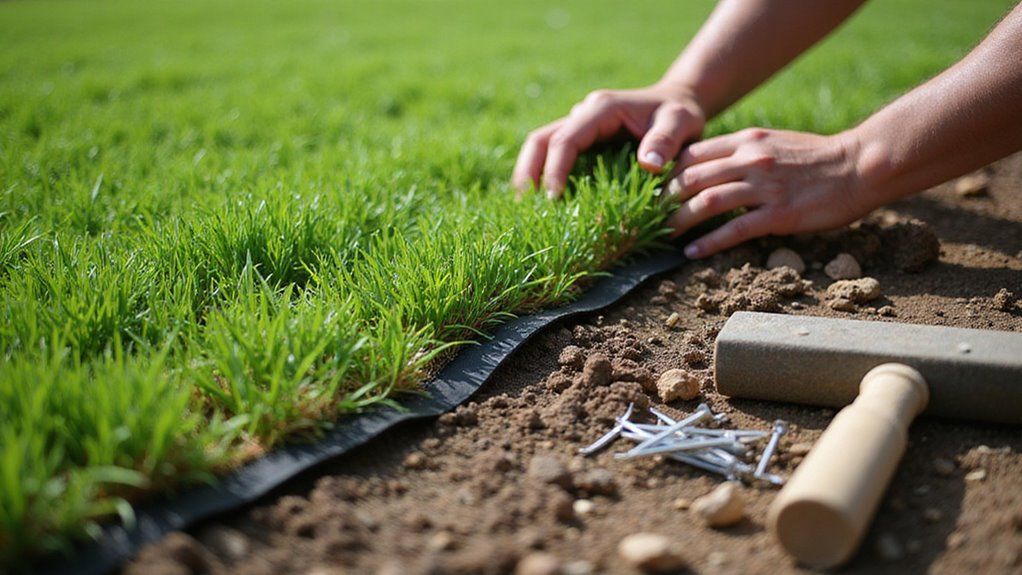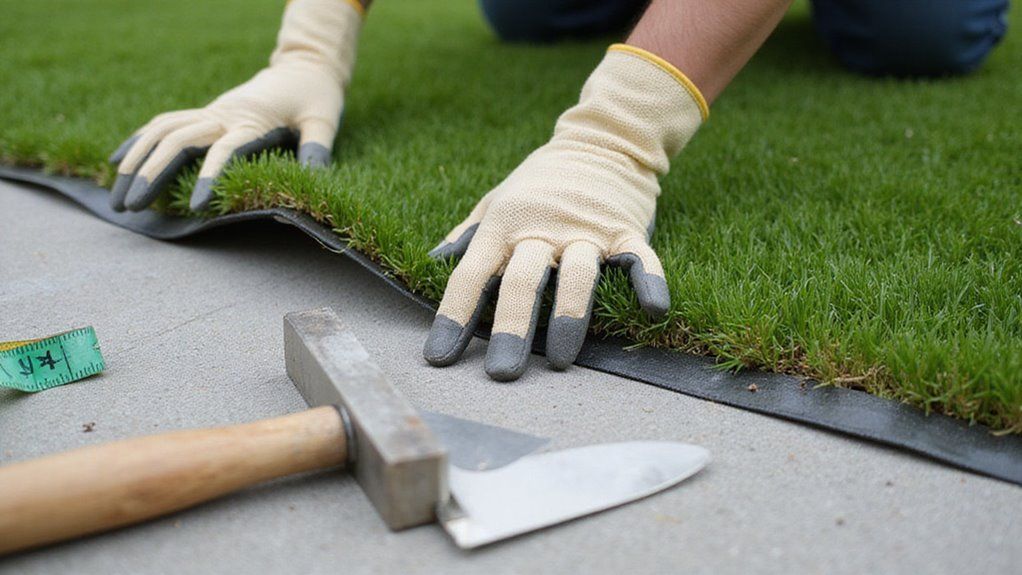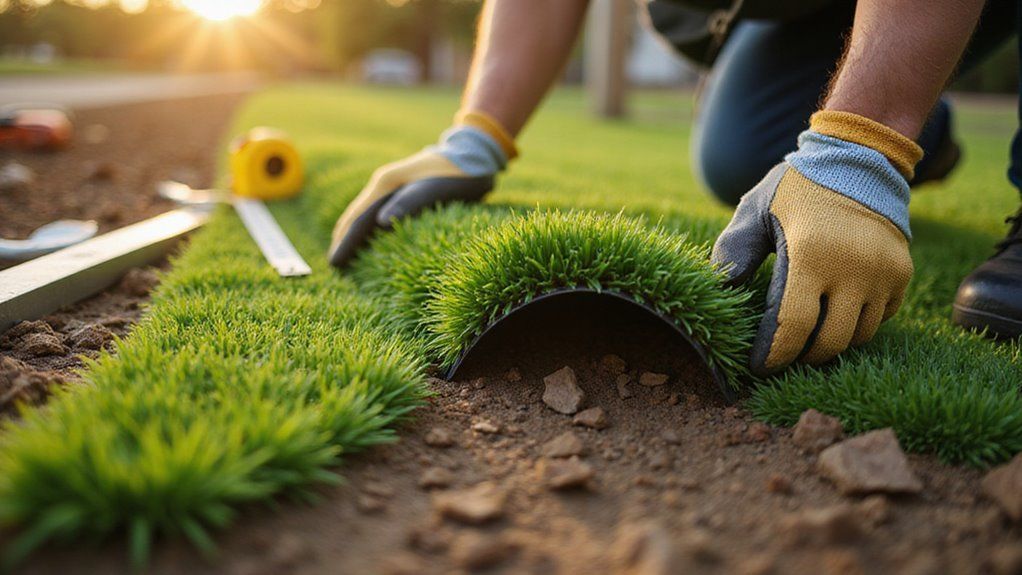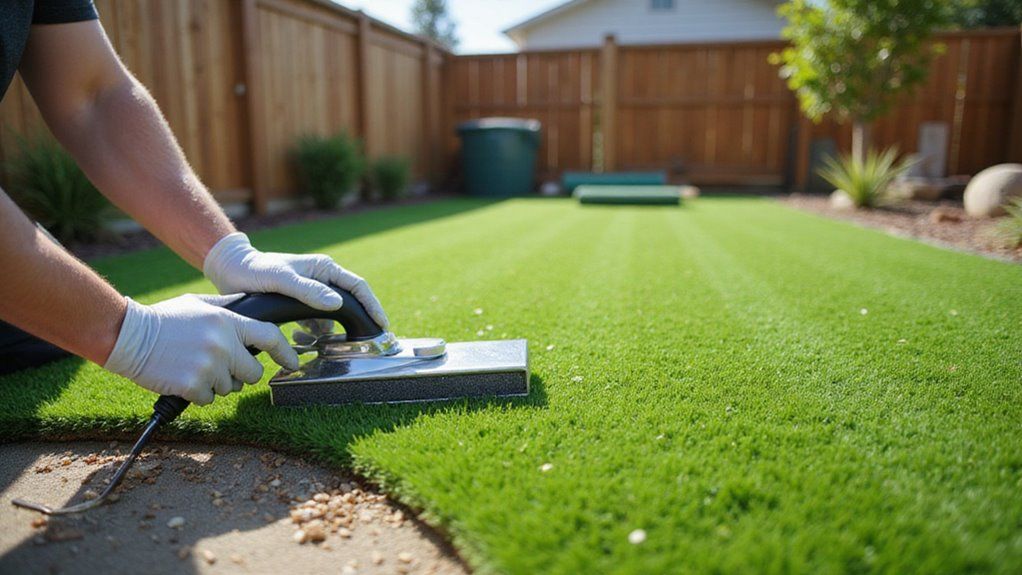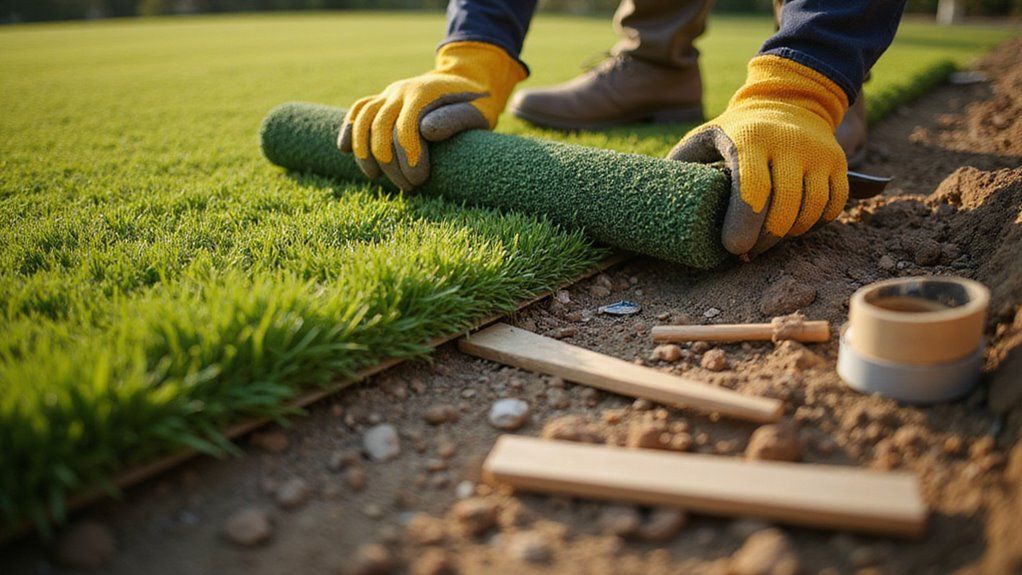How to Install Artificial Grass for Dogs
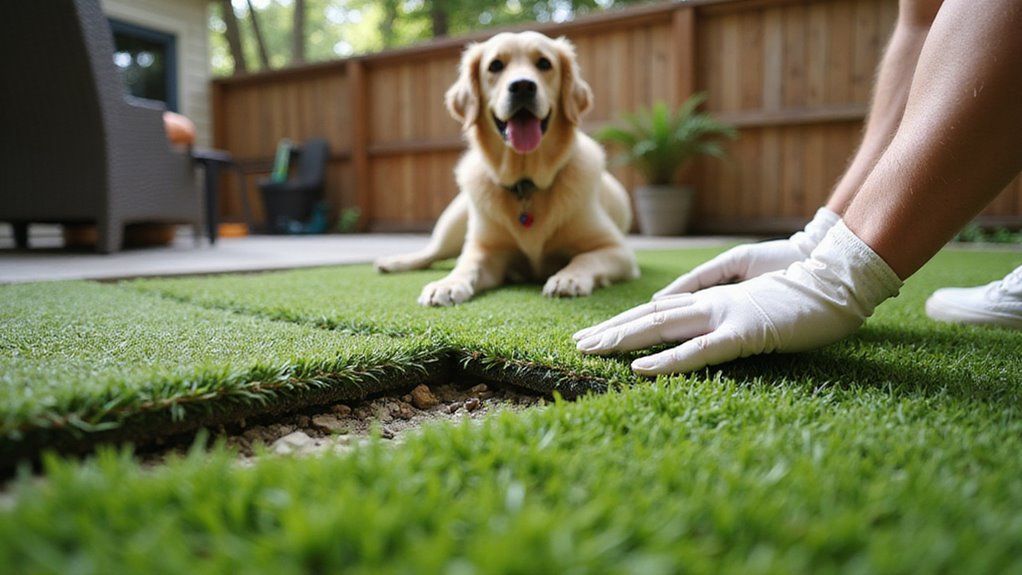
Gone are the days of muddy paw prints and torn-up yards from energetic dogs. Many pet owners struggle with maintaining a clean, safe outdoor space for their furry friends. Constant digging, patches of dead grass, and mud tracked inside create frustration and endless cleanup. Installing artificial grass offers a durable, low-maintenance solution that keeps both pets and owners happy.
To install artificial grass for dogs, start by removing 2-4 inches of soil and creating a slight slope for drainage. Add a crushed stone base with geotextile fabric and drain core sheets, then secure pet-safe turf using staples and adhesive. Finish with antimicrobial infill to control odors.
In this guide, we’ll explore everything you need to know about installing artificial grass for dogs.
Key Takeaways
- Excavate 2-4 inches of soil and create a 1-2% slope away from buildings for proper drainage and water management.
- Install 3-4 inches of crushed stone base with geotextile fabric, ensuring water filters through within 5-10 seconds when tested.
- Lay weed barrier fabric with 6-inch overlaps and secure edges with staples to prevent weed growth beneath turf.
- Secure turf with staples every 4-6 inches along edges and use turf adhesive with seaming tape for strong connections.
- Choose premium pet turf with 60+ ounces face weight and antimicrobial infill for durability and effective odor control.
Why Choose Artificial Grass for Your Dog?
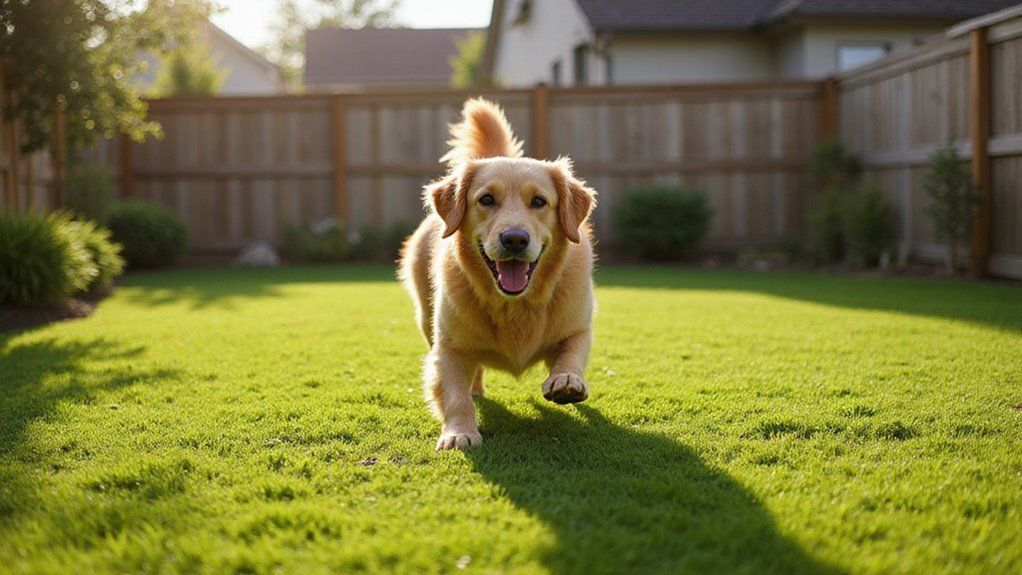
Artificial grass provides the ideal solution for dog owners seeking a durable, low-maintenance yard. Dogs quickly destroy natural grass through heavy traffic and urination. The synthetic turf stays clean and mud-free in all weather conditions.
Pet-friendly artificial grass contains special features for dogs. Research shows these surfaces reduce water usage by 70% compared to natural grass. The antimicrobial infill prevents bacteria growth and eliminates 99% of pet odors. Moreover, advanced drainage systems prevent flooding and waste buildup.
Furthermore, artificial grass creates a safer outdoor space for pets. The surface remains cool in summer heat and provides excellent traction year-round.
What Makes Dog-Friendly Artificial Grass Different?
Dog-specific artificial turf requires engineered features that standard landscape products lack. You’ll need non-toxic, lead-free materials paired with improved drainage systems that rapidly evacuate urine to prevent bacterial growth and odor accumulation.
The backing and blade construction must withstand repeated digging, scratching, and high-traffic wear patterns without deteriorating or exposing sharp edges that could injure your pet.
Pet-Safe Materials and Construction
Safe artificial grass for pets requires non-toxic materials and proper construction methods.
Pet turf must use lead-free polyethylene or polypropylene materials with UV protection. The backing contains antimicrobial treatments to fight bacteria from pet waste. These materials ensure long-term durability against claws and digging.
Furthermore, proper drainage prevents odors and bacteria growth. The turf backing needs drainage holes that process 30 inches of water per hour. Antibacterial sand infill offers better sanitation than rubber options. A drain core foundation helps water flow away quickly.
Drainage System Requirements for Pets
Pet-friendly artificial grass needs specialized drainage features to manage waste and rain. A proper system requires turf with 30-inch-per-hour water permeability and a 2 to 4-inch crushed stone base.
A geotextile fabric layer must be installed under the stone base for filtration.
Moreover, perforated turf backing prevents liquid pooling and bacterial growth. This design meets Florida DEP stormwater standards while protecting water quality. The complete system eliminates odors and keeps yards safe for families.
Durability Features for Active Dogs
Artificial grass for active dogs needs specific durability features to withstand heavy use. Premium pet turf requires face weights over 60 ounces per square yard for lasting resilience. Commercial-grade products with polyethylene or nylon fibers guarantee 10+ years of performance.
The right backing system plays a crucial role in durability. A triple-layer construction includes tufted anchoring, stability coating, and drainage perforations every 2-3 inches. Furthermore, UV stabilizers protect against sun damage.
Antimicrobial protection must extend throughout the fibers to control odors and resist bacteria. These features ensure your artificial grass stands up to digging, running, and pet waste.
How Much Does Artificial Grass for Dogs Cost?
Artificial grass for dogs costs between $8 to $18 per square foot in Florida. This price includes professional installation with pet-friendly materials and proper drainage systems.
A typical dog potty area requires specialized features that add $2 to $4 per square foot to the total cost. These features include antimicrobial infill and permeable base layers for optimal hygiene.
To reduce expenses, homeowners can choose DIY installation. Moreover, DIY projects cut labor costs by 40 to 50 percent. Additional materials like edging and infill contribute to the final price.
What Tools and Materials Will You Need?
Before you begin your artificial grass installation, you’ll need to gather the proper tools and materials to ensure a professional, pet-safe result.
Your equipment list should include excavation tools like a sod cutter and plate compactor, along with specialized items such as turf adhesive, seaming tape, and a utility knife for precision cutting.
You’ll also need to source base materials, drainage components, pet-friendly turf products, and antibacterial infill in quantities calculated for your specific project area.
Essential Tools for Installation
Essential tools for installing artificial grass include eight primary items. A sod cutter and shovel prepare the ground properly. A plate compactor ensures a stable foundation.
Basic installation requires a utility knife, turf adhesive, seaming tape, and push broom. These tools help create precise fits and secure edges. A wheelbarrow moves materials efficiently across the work area.
Additionally, a spreader helps distribute infill material evenly. These tools make the installation process smooth and professional. With proper equipment, homeowners can achieve lasting results.
Base Materials and Quantities
These base materials create a proper foundation for artificial grass in pet areas:
A 1.5-2 ton layer of crushed stone forms the essential drainage base per 100 square feet. Geotextile fabric needs 110 square feet to allow 10% overlap for complete coverage.
Drain core sheets require exactly 100 square feet for optimal pet waste drainage.
To control odors and maintain sanitation, 50-75 pounds of antibacterial infill sand should be spread per 100 square feet of turf.
This layered system ensures proper drainage and lasting freshness in dog areas.
For best results, each layer must be properly compacted and leveled before installing the artificial grass. Professional installation helps guarantee proper drainage and longevity.
Turf and Accessories Selection
Select antimicrobial artificial turf and safety-tested accessories for pets and outdoor spaces.
The safest turf systems use zeolite or silica infill to control bacteria and neutralize pet waste. Professional-grade drainage mats must handle at least 10 inches of rain per hour. Non-toxic adhesives create secure seams without harmful chemicals.
Quality materials protect pets while extending the turf’s lifespan. All components should meet ASTM F1292 safety standards for impact protection. A proper infill ratio ranges from 2-3 pounds per square foot of turf.
Moreover, look for UV-protected fibers that stay cool in direct sunlight.
How to Prepare Your Yard for Artificial Grass?
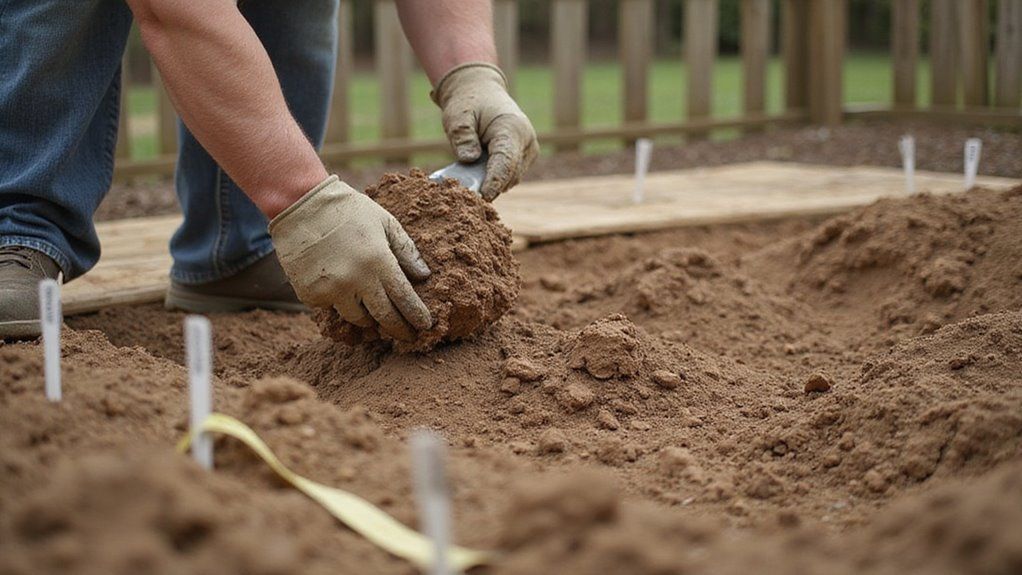
Proper yard preparation ensures your artificial grass installation delivers optimal drainage and longevity for high-traffic pet areas.
You’ll need to remove all existing vegetation, excavate to the correct depth (typically 2–4 inches), and establish proper grading to direct water flow away from structures.
Addressing Florida’s unique drainage challenges upfront prevents runoff issues and standing water that can compromise both turf performance and your dog’s health.
Removing Existing Grass and Vegetation
Remove old grass and plants completely before installing artificial turf for dogs. A thorough removal prevents future problems with drainage and settling.
Start by cutting away grass and roots with a sod cutter machine. Next, dig out 2 to 4 inches of topsoil to create proper depth. Clear all rocks, sticks, and plant matter from the area.
To ensure success, slope the soil gently away from buildings for proper drainage. These careful preparation steps protect both your investment and your dog’s wellbeing.
Excavation and Depth Guidelines
Excavate your turf base between 2 to 4 inches deep across the installation area. This depth ensures proper drainage and supports the turf backing effectively. A minimum 1-2% slope away from buildings prevents water accumulation.
Proper soil compaction creates a stable foundation for long-lasting results. A plate compactor helps achieve the necessary soil density. Furthermore, consistent depth throughout prevents low spots that collect pet waste.
Additionally, areas prone to flooding may require deeper excavation up to 6 inches. The right depth maintains proper sanitation and reduces unwanted odors in pet areas.
Addressing Drainage Issues
Proper drainage prevents water accumulation and turf damage. A well-designed drainage system needs 3-4 inches of crushed stone base beneath artificial turf. Water must flow freely through the base layers to avoid flooding.
A plate compactor ensures stable ground preparation. Pour water on the compacted surface to test drainage speed; it should filter through within 5-10 seconds. As a final step, lay geotextile fabric between layers to block soil migration.
Moreover, slope the base slightly away from structures at a 1-2% grade for optimal water flow. Regular maintenance checks help identify potential drainage issues early.
How to Install Artificial Grass for Dogs?
Installing artificial grass for dogs requires systematic execution of five critical phases to ensure durability and proper drainage.
You’ll begin by constructing a compacted base layer, then install permeable weed barrier and drainage systems to prevent flooding and contamination.
The process concludes with precise turf placement, pet-specific infill application, and finishing techniques that create a safe, functional surface for canine use.
Creating a Proper Base Layer
The best base layer consists of three key materials installed in sequence for proper drainage and stability.
Start by excavating 2 to 4 inches of soil and grade the area for optimal water flow. A layer of crushed stone forms the bottom foundation, requiring thorough compaction with specialized equipment. Drainage sheets come next to manage pet waste effectively.
As a final step, decomposed granite creates a smooth surface for the artificial turf. This complete system prevents odors and extends the life of your pet-friendly lawn installation. Professional installation ensures each layer functions correctly for lasting results.
Installing Weed Barrier and Drainage
Place weed barrier fabric and install proper drainage for optimal turf performance.
Lay landscape fabric across the prepared ground, with 6-inch overlaps between sections. Secure edges using landscape staples every 12 to 18 inches. The fabric blocks weeds while allowing water to pass through.
A drainage layer comes next for effective water management. Install drain core sheets underneath artificial grass to prevent water pooling. This system protects pets and maintains a clean, dry surface. The combined layers create excellent drainage, particularly important in rainy climates.
Laying and Securing the Turf
Secure artificial turf properly to create a safe, durable surface for pets. Place staples every 4 to 6 inches along wooden perimeter edges to prevent lifting. Apply turf adhesive and seaming tape between sections for strong connections.
For best results, weigh down sections with sandbags while the adhesive dries completely. A careful trim with a utility knife ensures clean edges and professional results. Moreover, proper installation prevents accidents and extends the turf’s lifespan.
Keep your pets safe by avoiding soil stapling where they might dig. This simple precaution protects both the turf and your animals.
Applying Infill Materials for Pets
Antibacterial sand makes the safest and most effective infill for pet turf areas. Apply 1-3 pounds of sand per square foot using a drop spreader for even coverage. A push broom helps work the infill deep into the artificial grass fibers.
Regular maintenance keeps the surface clean and odor-free. Rinse the turf weekly with plain water to remove debris. Monthly applications of enzyme-based cleaners eliminate lingering pet waste odors. These simple steps create a hygienic play area that lasts for years.
Brushing and Finishing Touches
Proper brushing creates an attractive and functional artificial lawn. A power broom or stiff push broom helps restore turf fibers to an upright position. Regular brushing maintains the grass appearance and supports effective drainage.
Final installation steps require inspection of seams for gaps and drainage testing with water. Each area should allow water to flow away naturally. Look closely at edges and corners for loose sections.
Pet owners must rinse waste areas daily and apply enzyme cleaner weekly for sanitation. Take photos to document the installation quality. These images help track wear patterns and guide future maintenance needs.
How to Maintain Dog-Friendly Artificial Turf?
You’ll need to establish a maintenance protocol to preserve your artificial turf’s performance and hygiene standards.
Regular cleaning practices, combined with targeted odor management techniques, prevent bacterial buildup and maintain optimal drainage function. Implementing systematic repairs and long-term care procedures extends your installation’s lifespan while ensuring a safe, sanitary environment for your dogs.
Regular Cleaning Practices
Regular cleaning keeps artificial pet turf hygienic and odor-free. Clean the surface monthly with enzyme-based products to dissolve pet waste and organic matter. Brush the infill material every two weeks to maintain proper distribution and antimicrobial protection.
Remove pet waste promptly to prevent bacteria growth and stains. This simple maintenance routine extends turf life and creates a healthier environment for pets.
Moreover, regular cleaning prevents unpleasant odors and maintains the turf’s appearance. A well-maintained surface provides years of safe, comfortable use for dogs.
Odor Management Techniques
Proper cleaning prevents odors from building up in artificial turf. Regular hosing of high-traffic areas removes urine and other contaminants effectively. Apply enzyme cleaners once per month to neutralize stubborn smells.
Good maintenance keeps artificial grass fresh and hygienic. A push broom redistributes infill material to maintain proper drainage. Antibacterial infill helps reduce unwanted odors naturally.
Quick action stops odors from spreading. Remove contaminated infill right away. Clean the area with diluted vinegar. Replace with fresh antimicrobial material promptly.
Repairs and Long-Term Care
Regular maintenance and timely repairs will extend your artificial turf’s lifespan to 15+ years. Basic inspections can prevent small issues from becoming major problems.
Check seams every 3 months for gaps and repair them with adhesive immediately. Add antimicrobial infill sand once per year to maintain proper density. Replace sections showing UV damage or wear within 2-3 years of first signs.
Keep detailed repair records to protect your warranty coverage. Moreover, schedule professional inspections annually to catch hidden damage early. These simple steps ensure your pet-safe turf remains safe and functional.
Transform Your Dog’s Yard Today with Synthetic Turf Treasure Coast
Professional synthetic turf installation transforms your dog’s yard into a clean, safe space. The right artificial grass system provides excellent drainage and antimicrobial protection for pets. Your installation must meet local stormwater codes and include pet-safe infill materials.
To handle Florida’s climate, proper turf installation requires careful attention to heat management and durability. Expert installers ensure the substrate allows water flow while preventing bacterial growth. Moreover, quality artificial grass stands up to active dogs while staying cool and hygienic.
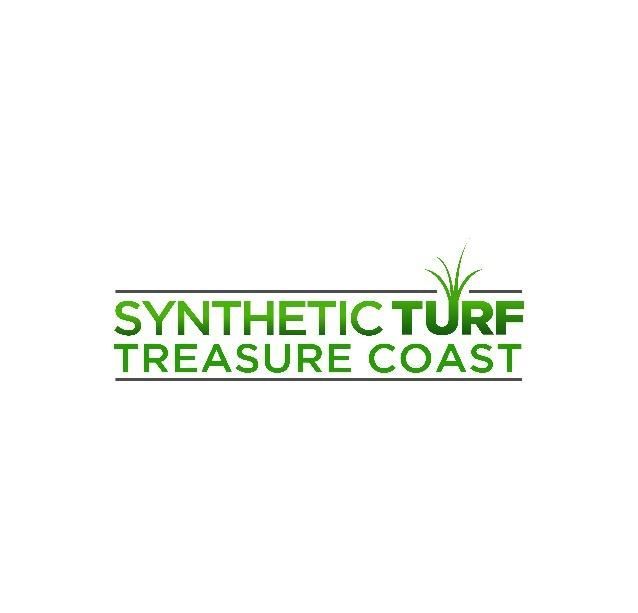
About the author
Kathy Leavell
Kathy Leavell is the founder and owner of Synthetic Turf Treasure Coast, a leading provider of synthetic grass solutions for residential and commercial properties in Florida. With over a decade of experience in the industry, Kathy has become a recognized expert in synthetic turf installation, maintenance, and repair. Under her leadership, Synthetic Turf Treasure Coast has earned a reputation for exceptional customer service and high-quality workmanship.
Prior to starting her own business, Kathy worked in sales and marketing roles at several major synthetic turf manufacturers.
